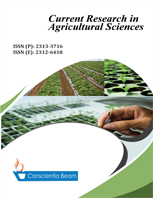Floristic Composition and Density of Main Woody Species of the Parklands in Two Phytogeographical Zones in Burkina Faso
DOI:
https://doi.org/10.18488/journal.68.2019.62.54.67Abstract
This study carries out in three villages belonging to the two phytogeographical zones (South-Sudanian and North-Sudanian sectors) in Burkina Faso. It intends to describe the floristic composition and calculate three main woody species density of the agroforestry parks in those two phytogeographical zones. The methodology consisted, on the one hand, to measure the area of fields and, on the other hand, the floristic species inventory. The results show that parklands in Bala (South-Sudanian phytogeographical zone) contains 14 species from 14 genus and 9 botanical families: Fabaceae-Caesalpinioideae, Fabaceae-Faboideae-Mimosoideae, Bombacaceae, Anacardiaceae, Meliaceae Combretaceae, Sapotaceae, Moraceae, and Verbenaceae. The parklands of Toessin and Bonogo (North-Sudanian sector) are rich of 51 species, 36 genus and 22 families which are, in additional to those cited in Bala Rubiaceae, Fabaceae-Faboideae, Ebenaceae Rhamnaceae, Balanitaceae, Anonnaceae, Myrtaceae, Bignoniaceae, Moringaceae, Apocynaceae, Sterculiaceae and Lythraceae. The calculation of trees density showed that the dominant woody species in the parks of Bala are in order of importance Vitellaria paradoxa, Parkia biglobosa and Tamarindus indica. Their maximum densities are respectively 66; 8 and 1 trees/ha. On the other hand, in Toessin and Bonogo, north-sudanian sector Lannea microcarpa, Vitellaria paradoxa, Parkia biglobosa predominate with maximum densities respectively from 34, 38 and 3 trees/ha.

